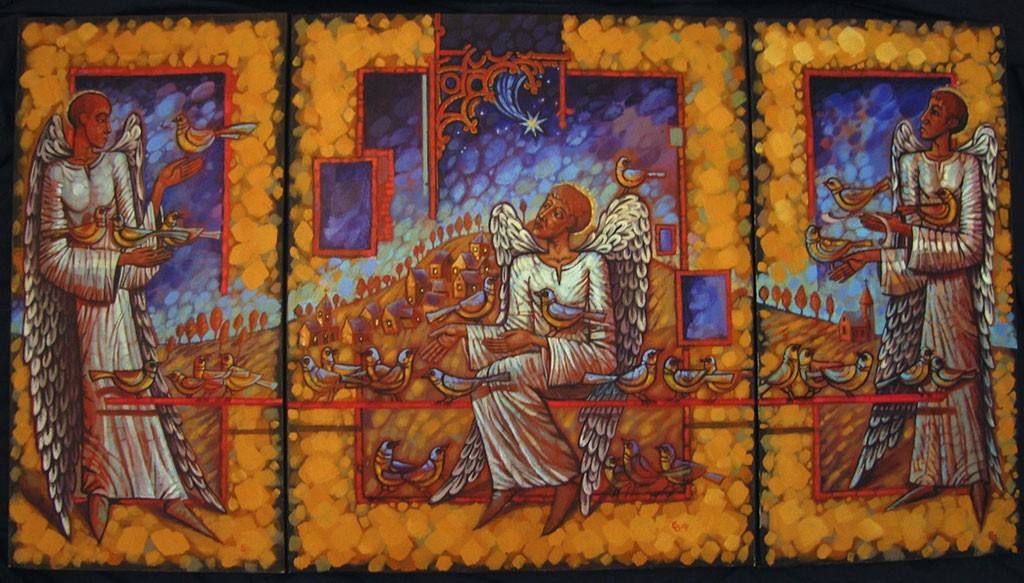You neglect anatomy, figure, perspective,
Salvador Dali
the entire mathematics of painting and coloristic,
so allow me to remind you,
these are rather the signs of laziness, but not genius.

You enter the workshop, feel a steady smell of the paint and solvent. Having approached to the window, you lift curtains. You take the pure, grounded canvas, establish it on the easel and fix it. You check the angle of the slope to allow the light to lay down exactly and without any patches of light on the canvas surface. Now you move a little bit away and have a look, you see how the future work will look. When you are completely sure in the correctness of the course of your thoughts, you approach to the canvas, get a palette and brushes. You squeeze out a paint a tube after a tube, accurately selecting the shades in the chosen scale. You don’t need a lot, some primary colors will be enough.
And here you understand it’s quite impossible to continue the further work in this way. You don’t have any mood to do something, you have neither emotions no feelings, the desire to take a brush in hands has completely disappeared. You start to think why, what is not correct? You finger the brushes one after one, searching for the correct one by the size and the form, but you find nothing. The surrounding silence starts to depress you. You approach to the window, view the cars passing by, the running passers-by. You notice that fine lady in red, admiring her before she turns. Then you sharply open the window, inhale some of the fresh, stupefying air. You stay for a while with the closed eyes and listen to the enveloping sounds of the city. But all these things don’t give the necessary effect and you depart from the window, take on the tape recorder and adjust it on your favorite channel. After some minutes of vain attempts to find something favoring to your mood you start the favorite playlist with the picked up compositions.
At last, having calmed down, you approach to an easel with the canvas established on it. Without reflecting you still select the necessary paints matching with the color tonality exactly in the chosen scale. You pour some of the solvent into the oiler and you take a brush in your hand, without choosing, at once guessing the necessary one on the size and form. And here you already stand with a palette and a rag in your left hand and a brush in the right one. You are resolute and adjusted. Invigorating music urges on to active actions. And, apparently, you are ready to make the most important thing…to spend the first dab on a pure, white surface. However in that second when you have already put a brush over a canvas the phone call is ringing. You put your hands down, the integral emotional impulse is interrupted. You throw all your things and keep the next insignificant talk. You go to the kitchen and you put a teapot on the fire. In five or ten minutes you come back into your workshop with a big mug of fragrant black tea. In full silence, sitting opposite to an easel in an old armchair, you drink slowly your tea and you think, you reflect, once again representing the appearance of your future work.
And here you rise, quiet and pacified already, ready to everything. Nothing disturbs you: telephone calls, the sounds of the city, the music that seldom matches with the tone of your mood. Nothing irritates you any more, even an unexpected wind gust that has disarranged the whole tulle, having stained it into the paint which appeared unluckily next to the window. You are adjusted and ready, take again an old palette with the oiler fixed on it and a rag in one hands and a brush in another. Slowly you approach to the canvas. Now you already know where and how you will make the first dab. After all the result of the future work depends on it. You moisten with a confident movement of the hand your brush in the solvent, take some of the white paint and add there some ultramarine, a drop only, for a sky subtle shade, and mix this color on a palette in a free corner. Having brought a hand with a flat brush to a canvas you do the first dab by a firm movement. It’s all, now work is begun, its final form is predetermined. No, certainly not all the questions are still solved, they just wait ahead, but after all it’s just you wait for, to put at last the last dab for your signature in the right bottom corner of the canvas in a month, two months or half a year, to call friends and to show them the result, how much you were right at the beginning, sitting in an armchair and seeing the future picture already finished on still absolutely white canvas.




